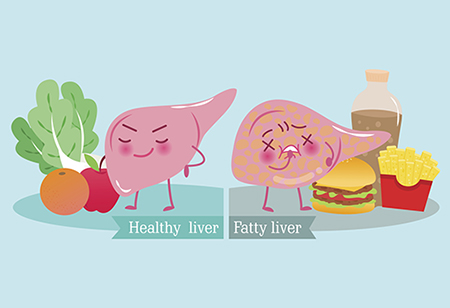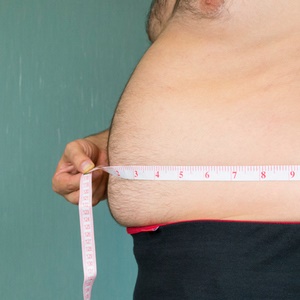What is fatty liver disease?
 |
There are two main types of this disease: nonalcoholic fatty liver disease (NAFLD) and alcoholic fatty liver disease. Having a fatty liver can leave you feeling tired or cause mild abdominal discomfort (fatty liver pain), but otherwise you may not have any symptoms. Signs of fatty liver can also include a feeling of fullness in the middle or upper right side of the abdomen, nausea, weight loss and a decrease in appetite. These are just some of the possible symptoms of fatty liver.
Is a fatty liver dangerous? It can be! The more severe type of NAFLD is NASH, which stands for non-alcoholic steatohepatitis. NASH causes the liver to swell and become damaged. According to the American Liver Foundation, NASH is one of the top causes of cirrhosis in adults in the United States and up to 25 percent of adults with NASH may already have cirrhosis. NAFLD is also linked to an increased risk of liver cancer.
Before you jump to the conclusion that a fatty liver may be a likely part of your future or a diagnosis you can’t do anything about, the good news is that the liver is highly regenerative — in fact, it’s the only organ that can regenerate itself.
That’s why it’s not that surprising that with the right fatty liver disease diet and some powerful yet easy-to-do fatty liver home remedies, you may be able to improve the state of your liver starting today!
What Is Fatty Liver Disease?
The human body’s largest organ is the liver. This vital organ stores energy, helps to digest food and removes toxins and poisons.
What is fatty liver disease? Fatty liver disease is a common health problem that results from a buildup of extra fat in the liver. It’s totally normal for the liver to contain a small amount of fat, but when fat storage reaches 5 to 15 percent of the liver’s total weight, then a person is said to have fatty liver disease.
The severity of a fatty liver (also called steatosis) can be a grade 1, grade 2 or grade 3 fatty liver. A fatty liver grade 2 is more serious and more likely to cause symptoms as compared to fatty liver grade 1. The more fat in the liver, the higher the grade and the more likely for the fatty liver to cause problems. There are also different kinds of fatty liver disease.
Nonalcoholic Fatty Liver Disease vs. Alcoholic Fatty Liver Disease
There are two main forms of fatty liver disease: non-alcoholic fatty liver disease (NAFLD) and alcoholic fatty liver disease. What causes fatty liver? In NAFLD, people have a buildup of fat in the liver that is not caused by alcohol use.
However, the build up of fat and damage to the liver is similar to what occurs in a case of alcoholic fatty liver disease, which is directly linked to consuming large quantities of alcohol. A “large amount” of alcohol is typically usually said to be more than one drink per day on average for women and more than two drinks per day on average for men.
Fatty Liver Symptoms
Now that you know what is fatty liver, it’s time to take a look at some of the ways you can identify this disease by knowing the common nonalcoholic fatty liver disease symptoms. First, it’s important to note that it is possible to have non-alcoholic fatty liver disease and exhibit no symptoms. This is actually quite common. When symptoms do occur, there are several possibilities.
Signs of a fatty liver (due to alcohol or other causes) can include:
Fatigue
Weakness
Loss of appetite
Nausea
Abdominal pain especially in the upper right abdomen
Swelling in the upper abdomen
Spider-like blood vessels
Itching
Jaundice (yellowing of the skin and eyes)
A build up of fluid and swelling of the legs (edema) and abdomen (ascites)
Mental confusion
Fatty Liver Causes
What causes a fatty liver? An excessive accumulation of fat leads to a fatty liver. In a diagnosis of alcoholic fatty liver disease, the main cause of fat accumulation is consuming large amounts of alcohol.
Suspected causes of nonalcoholic fatty liver disease (NAFLD) as well as non-alcoholic steatohepatitis (NASH) include:
Being overweight or obese
Insulin resistance
High blood sugar (hyperglycemia), indicating prediabetes or actual type 2 diabetes
High levels of fats, specifically triglycerides, in the blood
All of these possible causes seem to encourage excess deposits of fat within the liver with obesity likely being the most prevalent cause.
According to American College of Gastroenterology, NAFLD is a very common disorder affecting and may affect as many as one in three to one in five adults and around one in ten children in the United States. Obesity is thought to be the most common cause of fatty infiltration of the liver. Some experts estimate that about two thirds of obese adults and half of obese children may have fatty liver.
 |
Fatty Liver Risk Factors
What are the risk factors for fatty liver disease? Nonalcoholic fatty liver (NAFLD) is more common in people who exhibit any of these health problems or features:
Obesity
Type 2 diabetes
Prediabetes
Metabolic syndrome or another metabolic disorder
Hispanic
Rapid weight loss
High blood pressure
Middle aged or older (NAFLD is most prevalent in people who are middle-aged or older, but younger people including children can also have NAFLD)
Certain infections like hepatitis C
Take certain drugs including corticosteroids and certain cancer drugs
Exposure to some toxins
According to the Cleveland Clinic, “Some genetic metabolic conditions or prescription medications, including amiodarone (Cordarone®), diltiazem (Cardizem®), steroids, and tamoxifen (Nolvadex®) also may increase the risk of non-alcoholic fatty liver disease. If you are taking one of these medications and are diagnosed with fatty liver, your doctor might substitute another drug.”
Is having a fatty liver life threatening? If left untreated and it progresses, a fatty liver can definitely be life threatening. Let’s take a look at possible fatty liver health complications.
 |
Fatty Liver Complications
Non-alcoholic fatty liver disease (NAFLD) is the most frequent cause of liver disease in the Western world. Having fatty liver disease means that you have fat deposits within your liver and these undesirable deposits can prevent the liver from doing its important job (and what’s so crucial to optimal health) — to remove toxins from your blood. This puts someone with this liver disease at serious risk for toxic buildup and all kinds of unpleasant symptoms of a poorly functioning liver including jaundice, edema, chronic fatigue, nausea and more.
When non-alcoholic fatty liver disease progresses and becomes severe, it is then non-alcoholic steatohepatitis (NASH). According to the National Institutes of Health (NIH), between 7 and 30 percent of people with NAFLD will develop NASH and at least one-third of people with NASH eventually develop cirrhosis.
The late-stage scarring of the liver known as cirrhosis is the main complication of NAFLD and NASH. When cirrhosis occurs, liver cells are progressively replaced by scar tissue and liver function deteriorates more and more.
According to Mayo Clinic, approximately 20 percent of people with NASH will progress to cirrhosis, which can lead to:
Abdominal fluid buildup
Swelling of veins in your esophagus, which can rupture and bleed
Confusion, drowsiness and slurred speech
Liver cancer
End-stage liver failure (the liver has stopped functioning)
The need for a liver transplant
People with NAFLD, NASH and cirrhosis are all believed to be at an increased risk of developing liver cancer.
( Annie Price )
Recommended
 Handbook
Handbook
Vietnam Moves Up 8 Places In World Happiness Index
 Handbook
Handbook
Travelling Vietnam Through French Artist's Children Book
 Multimedia
Multimedia
Vietnamese Turmeric Fish among Best Asian Dishes: TasteAtlas
 Handbook
Handbook
From Lost to Found: German Tourist Thanks Vietnamese Police for Returning His Bag
Popular article
 Handbook
Handbook
Prediction and Resolution for the Disasters of Humanity
 Handbook
Handbook
16 French Films To Be Shown For Free During Tet Holiday In Vietnam
 Handbook
Handbook
Unique Cultural and Religious Activities to Welcome Year of the Snake
 Handbook
Handbook



